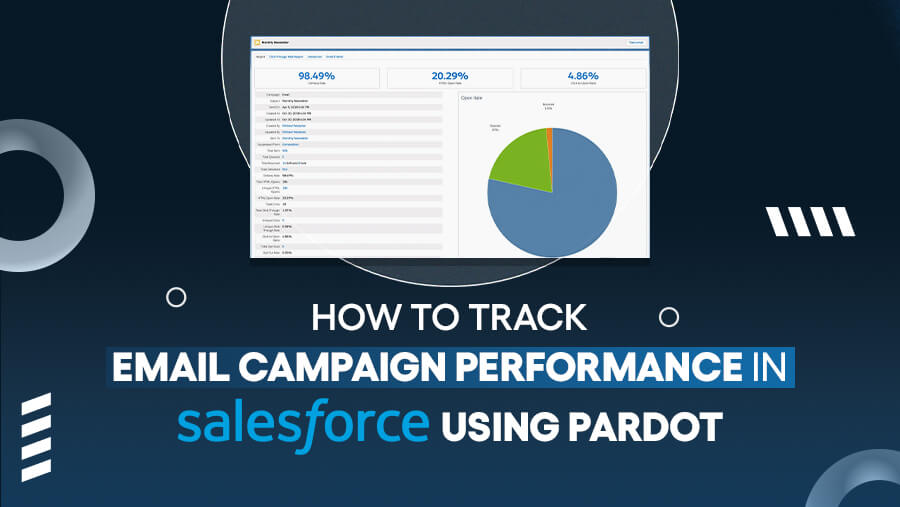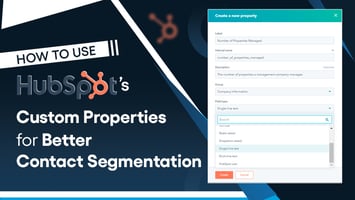
How to Track Email Campaign Performance in Salesforce Using Pardot
Anisha

What does tracking your email campaign’s performance entail? Besides knowing who opened your emails or clicked a link, tracking also involves understanding what’s working and what’s not.
When you see how your emails drive engagement, you get valuable insights to fine-tune your strategies. That’s where tools like Salesforce and Pardot come in.
Together, they give you a clear view of your email campaigns, helping you make data-driven decisions to improve results.
In this blog, we’ll explore how to set up email tracking in Pardot, key metrics to monitor, and ways to optimize your campaigns for better performance. Let’s dive in!
Step 1: Set Up Pardot for Email Tracking
Email tracking in Pardot starts with seamless integration with Salesforce. This integration ensures all your campaign data flows effortlessly, allowing for accurate tracking and reporting. Here's how you can get started:

Set Up Email Tracking in Pardot
The next step is to configure email tracking in Pardot. Here’s how:
1. Access the Email Template BuilderLog into Pardot and navigate to the "Marketing" section to create or customize email templates.
2. Enable Email Tracking FeaturesActivate tracking options in the template settings, such as open rate, click-through rate (CTR), and bounce rate.
3. Add Tracking LinksIncorporate UTM parameters or custom redirect links to monitor user interactions.
4. Sync Campaign DataEnsure Salesforce is synced to capture engagement metrics like email opens, clicks, and conversions.
E. Automate ReportingSet up automated workflows in Pardot to send performance updates directly to your team.
Leverage Key Features
With these features in place, you’re ready to track your email campaigns and gather actionable insights:

Next, look at the metrics you should monitor for maximum impact.
Step 2: Monitor Key Metrics in Pardot
Tracking the right metrics in Pardot is essential for understanding the success of your email campaigns. Each metric tells a unique story about your audience’s behavior and your campaign’s performance.
Here's a breakdown of the key metrics you should monitor:
1. Open Rates
The open rate shows how many recipients opened your email. This metric indicates the effectiveness of your subject line and the timing of your send. A low open rate could signal issues like unappealing subject lines or emails sent at inconvenient times.
Tip: Test different subject lines and send times to optimize this metric.
2. Click-Through Rates (CTR)
CTR measures the percentage of recipients who click on a link within your email. This reflects how engaging and relevant your content is to your audience.
Tip: Use clear call-to-action (CTA) buttons and test different link placements to improve CTR.
3. Bounce Rates
A bounce rate represents the percentage of emails that couldn’t be delivered. High bounce rates can harm your sender's reputation and reduce future deliverability.
Tip: Regularly clean your email list to remove invalid addresses and improve deliverability.
4. Conversion Rates
Conversion rates track how many recipients completed a desired action, such as filling out a form or purchasing after engaging with your email.
Tip: Ensure your email’s content aligns with the landing page to create a seamless user experience.
5. Unsubscribe Rates
This metric shows how many recipients opted out of your emails. While some unsubscribes are natural, a sudden spike can indicate that your content isn’t meeting audience expectations.
Tip: Segment your audience to ensure your content is tailored to their interests and preferences.
Step 3: Use Pardot Reports for Performance Analysis
Pardot’s reporting tools make it easier to evaluate email campaign performance and gain actionable insights. Here’s how you can harness these features effectively:
Generate and Customize Email Performance Reports
Pardot enables you to create detailed reports on email performance. These reports cover key metrics like open rates, click-through rates, and conversions.
Customization options allow you to focus on specific campaigns or segments, giving you a clear view of what’s working and needs improvement.
Example: Customize reports to track performance for high-value prospects or specific email templates.
Analyze Trends with Pardot’s Built-in Analytics Tools
Pardot provides built-in tools to identify trends across campaigns. Use these tools to spot patterns, such as which types of content drive higher engagement or which times yield better results.
Key Questions to Explore:
- Are your open rates improving over time?
- Which CTAs result in higher conversions?
- Are certain subject lines consistently outperforming others?
Visualize Data with Charts and Dashboards
Visual representation of data helps you quickly identify strengths and weaknesses. Pardot’s dashboards provide an at-a-glance summary of email performance, while charts can highlight trends in engagement, conversions, and other metrics.

Pardot reports help you assess your email campaigns' current state and guide future optimizations. By leveraging these insights, you can align your strategy with your audience's preferences and achieve better outcomes.
Step 4: Leverage Salesforce for Deeper Insights
Combining Pardot’s marketing capabilities with Salesforce’s sales-driven tools gives you a comprehensive view of your email campaign performance and its impact on revenue. Here's how to unlock deeper insights:
Sync Pardot Data with Salesforce for Lead Tracking
When Pardot data is synced with Salesforce, you gain a unified platform for tracking how email campaigns influence leads. This integration allows you to:
- Track lead engagement at every touchpoint.
- Assign lead scores based on email interactions and other activities.
- Identify which campaigns contribute to pipeline growth.
With synchronized data, sales teams can prioritize high-quality leads while marketing teams refine their outreach strategies.
Use Salesforce Dashboards to Measure Campaign Impact
Salesforce dashboards provide a holistic view of how email campaigns influence sales outcomes. Use dashboards to:
- Visualize email-driven revenue growth.
- Monitor lead-to-opportunity conversion rates.
- Assess how specific campaigns contribute to each sales stage.
These dashboards make connecting marketing efforts to tangible sales results easy, ensuring alignment between both teams.

By leveraging the Salesforce-Pardot integration, you get a 360-degree view of your email campaigns. This improves lead nurturing and sales alignment and ensures that every marketing dollar is working hard to drive measurable results.
Step 5: Optimize Campaigns Based on Data
Data-driven decisions are the key to improving email campaign performance. By analyzing metrics and leveraging insights from Pardot and Salesforce, you can fine-tune your campaigns for better results.
Identify Underperforming Campaigns and Improve Them
Review key metrics like open rates, CTR, and bounce rates to pinpoint campaigns that need attention. Look for:
- Low Open Rates: Adjust subject lines or delivery times.
- High Bounce Rates: Clean up email lists to ensure valid contacts.
- Low CTR: Revise email content or calls-to-action.
Use this information to create actionable plans that directly address performance gaps.
A/B Test Email Elements Using Pardot
Pardot makes it simple to test different components of your emails. Conduct A/B tests to identify what resonates best with your audience:
- Subject Lines: Try personalized vs. generic headlines.
- Email Body: Compare concise messaging vs. detailed explanations.
- CTAs: Experiment with different placements, colors, and wording.
You can confidently refine your approach by running tests to determine what works for your audience.
Adjust Targeting and Segmentation
Leverage tracking insights to enhance audience segmentation. For example:
- Group leads based on engagement levels (e.g., highly engaged, mildly engaged).
- Adjust email frequency for different segments to avoid unsubscribes.
- Personalize emails based on demographics or past interactions.
Refined targeting ensures that your emails are relevant, timely, and aligned with your recipients’ needs, increasing engagement and conversion rates.
Conclusion
Tracking email campaigns is essential for improving ROI and ensuring your marketing efforts align with audience expectations. By leveraging Pardot’s tracking tools and integrating them with Salesforce, you gain actionable insights to enhance engagement and drive conversions.
Consistent analysis and optimization of your email strategies ensure every campaign performs at its best.
Ready to elevate your email marketing? Explore Pardot and Salesforce today to unlock smarter tracking and better results for your campaigns.
News Letter
Subscribe our newsletter to get our
latest update & news


